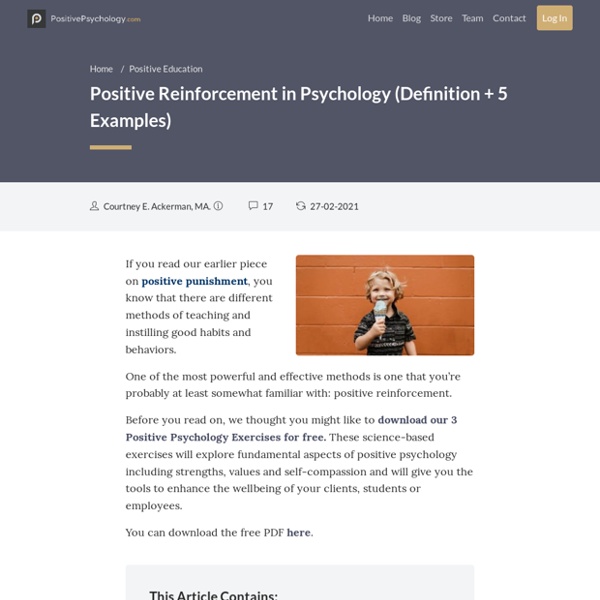(Positive Punishment and Negative reinforcement examples) 12 Examples of Positive Punishment & Negative Reinforcement
You might be thinking that “positive punishment” sounds like an oxymoron, after all, how can punishment be positive? Not many people “like” punishment, right? The disconnect in understanding this concept comes from the usage of the word “positive;” here at PositivePsychology.com, we generally use the term “positive” to refer to things that are inherently good, things that are life-giving, and things that promote thriving and flourishing. The concept of positive punishment comes from a very different era and a very different perspective on psychology; namely, the 1930s and behaviorism. So, what actually is positive punishment and how does it relate to parenting, teaching, and even the workplace?
Reinforcement vs Punishment Psychology [Examples]
Reinforcement and punishment are often used as parenting tools to modify children’s behavior. Let’s review the difference between positive reinforcement and negative reinforcement, and the difference in outcomes between them. The Difference Between Positive And Negative Reinforcement In behavioral psychology, reinforcement is the introduction of a favorable condition that will make the desired behavior more likely to happen, continue or strengthen in the future1.
Negative Reinforcement: What Is It and How Does It Work?
What is negative reinforcement? Negative reinforcement is a method that can be used to help teach specific behaviors. With negative reinforcement, something uncomfortable or otherwise unpleasant is taken away in response to a stimulus. Over time, the target behavior should increase with the expectation that the unpleasant thing will be taken away. Read on to learn more about this type of learning. The relationship between behavior and consequences is part of a type of learning called operant conditioning.
10 Tips for Improving Parent-Teen Relationships
You know your child is an adolescent (semi-formed human) when she or he: Gives you attitude over stuff that's never been an issue before. Refuses to do what you ask. Agrees to do it and then (un)wittingly "forgets"
(Negative Punishment examples) Negative Punishment Examples and Scenarios
Nobody ever wants their stuff taken away. That is the main concept behind negative punishment. Using negative punishment example scenarios, gain an understanding of the concept and its effectiveness. Then, go on to explore the difference between positive and negative punishment. Exploring Negative Punishment The use of punishment is one way to deter or eliminate undesired behavior.
Reinforcement vs. Punishment: Changing Behavior
Being a parent has been known as the best thing ever BUT also the most challenging endeavor you will encounter in your lifetime. Parents strive to raise a healthy and happy child that will one day grow up as a full-fledged mature and independent adult. But to successfully accomplish this goal, a parent must set forth structure or rules throughout their childhood to help them understand and be realigned when their behavior needs to be modified. When a parent recognizes the need to change a behavior, they will likely end up using either reinforcement, punishment, or a mixture of both.
Positive Punishment: What It Is, Benefits, and Examples
Positive punishment is a form of behavior modification. In this case, the word “positive” doesn’t refer to something pleasant. Positive punishment is adding something to the mix that will result in an unpleasant consequence. The goal is to decrease the likelihood that the unwanted behavior will happen again in the future.
A Parent's Guide to Surviving the Teen Years
You've lived through 2 a.m. feedings, toddler temper tantrums, and the back-to-school blues. So why is the word "teenager" causing you so much worry? When you consider that the teen years are a period of intense growth, not only physically but emotionally and intellectually, it's understandable that it's a time of confusion and upheaval for many families. Despite some adults' negative perceptions about teens, they are often energetic, thoughtful, and idealistic, with a deep interest in what's fair and right.
Difference Between Negative Reinforcement And Punishment - Evolution Counseling
Behavioral Psychology By Michael Schreiner | March 20, 2015 A question that always pops up in behavioral psychology is what the difference is between negative reinforcement and punishment.
Negative Reinforcement: What Is It and How Does It Work?
What is negative reinforcement? Negative reinforcement is a method that can be used to help teach specific behaviors. With negative reinforcement, something uncomfortable or otherwise unpleasant is taken away in response to a stimulus. Over time, the target behavior should increase with the expectation that the unpleasant thing will be taken away. Read on to learn more about this type of learning.
Positive Punishment
Positive punishment is the practice of adding a punishment and can be contrasted to negative punishment, which is the process of taking away something pleasant. Timeouts and extra chores are examples of positive punishment. Although spanking may be a form of discipline, the American Academy of Pediatrics advises against spanking children. Positive punishment can be an effective component of a parent's disciplinary repertoire.
10 Positive Punishment Techniques & Their Effect
By: Ashley Brown Updated February 11, 2021 Medically Reviewed By: Laura Angers As a parent, it is natural to wonder about the best way to teach your child right from wrong. Punishing them is no fun, but sometimes it has to be done if you want their behavior to change.



